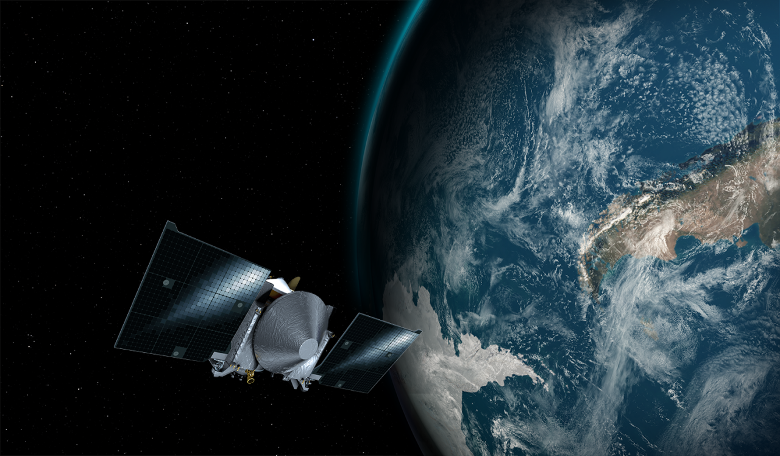Today, NASA’s asteroid sample return mission, OSIRIS-REx, will whizz round the Earth and use our planet’s gravity like a slingshot to fling it on direct course towards asteroid Bennu.
OSIRIS-REx, which stands for Origins, Spectral Interpretation, Resource Identification, and Security – Regolith Explorer will pass the Earth around 17,000 kilometres above us in order to perform a manoeuvre known as an Earth Gravity Assist.
Along with saving fuel, this manoeuvre allows the spacecraft to ’borrow’ a small amount of Earth’s orbital energy. This will help increase the crafts orbital inclination so that it is hurled back out into space on the correct path to rendezvous with its target; Bennu
Bennu is a B-type asteroid with a ~500 meter diameter. It completes an orbit around the Sun every 436.604 days (1.2 years) and every 6 years comes within 0.002 AU of Earth (1 AU = the distance between Earth and the Sun, or ~93 million miles).
Its distance from the Earth, along with its composition, helped Benny to be selected from the 500, 000 known asteroids out in the Solar System. Benny is carbon-rich (where the b comes from in its designation as a b-type asteroid) and its chemical make-up reflects the type of material that was around in the early Solar System. It is essential a flying fossil that can give clues as to how the rocky planets could have started out 4.6 billion years old, give or take a few million years.
As such Bennu may contain the molecular precursors to the origin of life and give clues as to how Earth got its oceans.
Launched just over a year ago while strapped to an Atlas V rocket from Cape Canaveral, Florida, OSIRIS-Rex has already unfolded its solar panels in the first step of its mission. After its gravity assist today, the spacecraft will continue on its journey towards Bennu, however OSIRIS-Rex will not start its approach to the asteroid until August 2018.
At this point the spacecraft will be approximately two million kilometres away from its target and to complete its mission, OSIRIS-Rex will need to fire its small rocket thrusters so that the spacecraft slows down to match the same velocity as Bennu – around 63,000 mph.
A survey to map Bennu’s geological properties, as well as a search for asteroid plumes and natural satellites will start from October 2018 and last for at least a year. Following its initial analysis, a sample site will be selected and the spacecraft will move into position so that it can collect a sample of Bennu’s surface material. This will be done with TAGSAM; the Touch-and-Go Sample Acquisition Mechanism – a robotic arm with an attached sampler head. The collected sample of Bennu’s surface is expected to return to Earth in 2023.
The spacecraft has already been spotted earlier this month by the Large Binocular Telescope Observatory in Arizona. However amateur astronomers with the right specialised equipment should be able to see OSIRIS-REx as the spacecraft approaches and retreats from its closest position over Earth yet.











